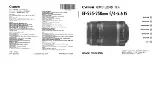
12
2. Attach the DC-type auto iris lens to the lens mount on the front of the camera.
3. Plug the connector into the auto iris jack on the side of the camera. The connector is
polarized and can only inserted into the jack one way.
4. Apply power to the camera.
3) Manual IRIS lens adjustment
When using a manual iris lens, turn the iris ring on the lens to the OPEN position and adjust the
manual iris for the appropriate range. Adjust during the brightest conditions, opening the lens to
the minimum f-stop yielding a good picture under the brightest scene conditions. Do not saturate
the picture.
The manual iris is used in indoor applications where lighting from windows can considerably
affect the light level of the room.
4) Back Focus adjustment
For best results, perform back focus adjustments at night or while using a #6 or #8 welder's
glass in front of the lens. The focus of the camera will change slightly if the camera iris was
adjusted on a light scene, then changes to a dark scene. However, the camera will remain in
focus if the iris was focused on a dark scene and the scene lightens.
1. The lens should be mounted on the camera before applying power.
2. If a picture is visible, focus on the picture. If the picture is not visible, open the iris on the
lens. Open the lens as wide as possible by placing the welder's glass in front of the lens and
forcing the lens to automatically open.
3. When the iris is open to the widest point, re-adjust the focus for clear picture. If a clear
picture is not possible, set the focus ring to midrange.
4. Loosen the back focus lock screw.
5. Adjust the back focus ring for a clear picture.
6. Tighten the back focus lock screw.













































